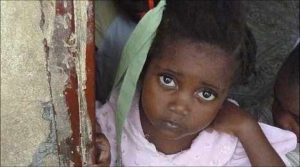
In the dim late afternoon light, seeping through an upstairs window, the scars of ant bites are clearly visible on the back of a small baby boy.
Jean was found covered in ants in a cardboard box half-filled with rain water near a busy Port-au-Prince market.
“He was half-dead,” says Nicole Dieudonne, director of an orphanage on the outskirts of the capital. “If it wasn’t for a hole in the box he would have drowned.”
Desperate mothers
Jean, who is wheezing terribly, is one of many children that have been brought to the orphanage’s door since last January’s earthquake.
Nicole says there has been a 30% increase in intake during this period, and she is often unable to take more children.
Visibly affected by what she is telling me, she adds that many mothers are becoming increasingly desperate.
“I know people who have left their children in ditches, by the market, in the street, in the bush, anywhere,” she explains.
“Last week there was a mother walking her child and looking for someone to give her away to. But she could not find anyone to take the child so she killed her, she killed that child.”
Almost 5,000 children are registered as having lost contact with their families – a list that has grown 60% since the earthquake.
About a quarter of the children have now been reunited with parents or relatives, but most of the others will find themselves in orphanages.
About half of these homes, unlike the one I visited, are not registered with local authorities.
Unicef child protection specialist Christina Torsein says it is a very worrying situation, with reports of abuse in some homes.
“In addition to being unaccredited, there are poor standards, there are malnutrition issues, there are issues of child abuse and sexual violence. One needs to be quite frank about what the unfortunate reality is.”
Trafficking threat
The plight of Haiti’s children has got much worse since the earthquake. But it was also grim for many before the disaster, too.
For decades, many children here have been given away to other families, usually ones they do not know, by parents who are too poor to feed and clothe them.
Many of these children, known as restaveks, do not go to school, are made to do strenuous chores without pay and are often beaten and abused.
 Nicole Dieudonne with baby Jean, who was found in a cardboard box
Nicole Dieudonne with baby Jean, who was found in a cardboard boxJust before the earthquake it was estimated that there were 250,000 restavek children in Haiti. It is thought likely that this number will have grown significantly over the past year.
Then there is the threat from child traffickers. Around 2,000 children each year are thought to fall victim to such people, who usually smuggle them abroad.
Chaos following the earthquake will have made the job even easier, despite increased efforts by police and child protection charities.
Haiti has long had a culture of violence, too, that has created its own share of orphans. Sitting quietly under an awning watching the other children play is 11-year-old Leslie Joseph.
“My mother and father were working on a farm when they came to kill them,” he recalls. “They dragged them away and stabbed them to death with machetes. I couldn’t do anything. I was too small.”
Leslie was five when this happened right in front of him. He does not know who the killers were or why they did it. Now he will spend the rest of his childhood here with 40 or 50 other orphans.
Baby boom
Another factor fuelling the number of orphans is the growing number of children now being born here. According to a report by the UN Population Fund the country’s birth rate has tripled since the earthquake.
This might explain the name given to a maternity hospital I visited near the city’s notorious Cite Soleil slum district. It has become known as the “baby factory”.
“We have somewhere between 30 and 40 deliveries a day,” says Medecins Sans Frontieres midwife Felipe Rojas Lopez.
“This makes around 1,200 a month. Every day we have full capacity. In my professional life I have never seen a hospital that works at this volume.”
It is not only the midwives and doctors who struggle to keep up with it all.
Many mothers discharge themselves hours or even minutes after giving birth and walk away without their babies when staff are not in the room. To my left, a tiny baby is being cradled in the arms of MSF project coordinator, Tara Newell.
“He is three weeks old. He has been with us all that time,” she tells me. “He’s perfectly healthy and is a baby who loves to be cuddled but his mother abandoned him here on the day that he was born. This happens quite often.”Nobody knows for sure how many children have been left to live on Haiti’s impoverished streets. Children’s charities estimate that it could amount to 3,000 or more.
Again, the earthquake has swelled their numbers.
Some will have found shelter in one of the many large camps for the displaced, which are still home to about a million people. For those children it could well be a case of out of the frying pan into the fire.
According to a report just published by Amnesty International, children as young as five are being raped in camps set up to rehouse earthquake victims, along with hundreds of women.
Back at the orphanage, Nicole Dieudonne says she is grateful for the help her country has received from all over the world since the earthquake.
But in the future, she insists, Haiti must put its faith in its children.
“There is hope if Haitians stand together, if they get the children from the streets and teach them how to work and how to respect others. But if they do not, Haiti will perish.”